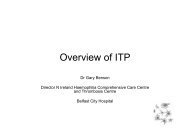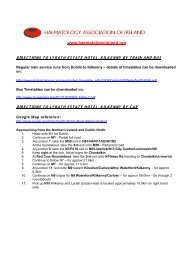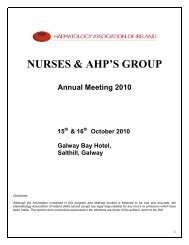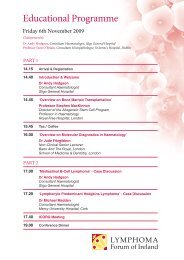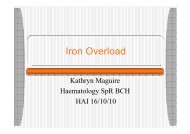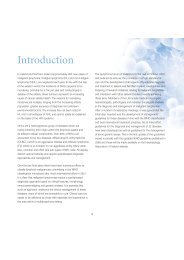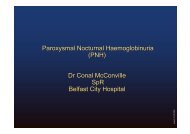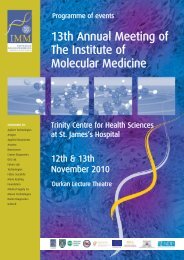Guidelines on Diagnosis and Treatment of Malignant Lymphomas
Guidelines on Diagnosis and Treatment of Malignant Lymphomas
Guidelines on Diagnosis and Treatment of Malignant Lymphomas
Create successful ePaper yourself
Turn your PDF publications into a flip-book with our unique Google optimized e-Paper software.
Burkitt Lymphoma/Leukaemia<br />
Definiti<strong>on</strong> <strong>and</strong> Incidence<br />
Burkitt lymphoma (BL) is an aggressive lymphoma, which<br />
frequently presents at extranodal sites or as acute leukaemia.<br />
The lymphoid proliferati<strong>on</strong> is composed <strong>of</strong> m<strong>on</strong>omorphic,<br />
medium-sized B-cells with basophilic cytoplasm <strong>and</strong> numerous<br />
mitotic figures. Translocati<strong>on</strong> involving MYC is a c<strong>on</strong>stant genetic<br />
feature <strong>and</strong> EBV is found in a variable proporti<strong>on</strong> <strong>of</strong> cases. The<br />
disease is rare with an incidence rate <strong>of</strong> < 0.2 / 100,000 / year<br />
<strong>and</strong> sporadic BL accounts for 1-2% <strong>of</strong> lymphomas in Western<br />
Europe <strong>and</strong> the USA. BL accounts for 30-50% <strong>of</strong> all childhood<br />
lymphomas. The median adult age <strong>of</strong> <strong>on</strong>set is 30 years <strong>and</strong> the<br />
male:female ratio is 2-3:1. Endemic BL occurs in equatorial<br />
Africa <strong>and</strong> Papua New Guinea which corresp<strong>on</strong>ds to the<br />
distributi<strong>on</strong> <strong>of</strong> malaria <strong>and</strong> has a peak incidence in childhood (4 -<br />
7 years). Immunodeficiency associated BL is primarily associated<br />
with HIV infecti<strong>on</strong> <strong>and</strong> is <strong>of</strong>ten the AIDS – defining illness.<br />
ICD – O Code:<br />
9687/3 (lymphoma)<br />
9826/3 (leukaemia)<br />
Clinical Presentati<strong>on</strong><br />
Patients with sporadic BL present with abdominal masses<br />
frequently <strong>of</strong> the ileo-caecal regi<strong>on</strong>, a nasopharyngeal mass<br />
or leukaemia. Other presentati<strong>on</strong>s include involvement <strong>of</strong><br />
the ovaries, kidneys <strong>and</strong> breasts. Retroperit<strong>on</strong>eal disease may<br />
be associated with spinal epidural compressi<strong>on</strong> resulting in<br />
paraplegia. B<strong>on</strong>e marrow involvement in a primarily<br />
lymphomatous presentati<strong>on</strong> is a poor prognostic feature <strong>and</strong><br />
is found in patients with a high tumour burden. Such patients<br />
have a high LDH <strong>and</strong> uric acid levels <strong>and</strong> are at risk <strong>of</strong> the<br />
tumour lysis syndrome.<br />
Pathology<br />
Classical BL is composed <strong>of</strong> medium sized cells, with round<br />
nuclei, clumped chromatin <strong>and</strong> numerous nucleoli. The cytoplasm<br />
is deeply basophilic <strong>and</strong> usually c<strong>on</strong>tains lipid vacuoles. There is a<br />
high proliferati<strong>on</strong> rate with numerous mitotic figures <strong>and</strong> “starry<br />
sky” pattern due to the presence <strong>of</strong> numerous benign<br />
macrophages which have ingested apoptotic tumour cells.<br />
Immunophenotype<br />
Tumour cells express membrane IgM with light chain restricti<strong>on</strong><br />
<strong>and</strong> B-cell associated antigens such as CD 19, 20 <strong>and</strong> 22. CD10<br />
<strong>and</strong> BCL6 are also expressed. The cells are negative for CD5,<br />
CD23 <strong>and</strong> BCL2. A very high growth fracti<strong>on</strong> is observed <strong>and</strong><br />
nearly 100% <strong>of</strong> cells are positive for Ki 67. Infiltrating T-cells are rare.<br />
The blast cells <strong>of</strong> BL presenting as leukaemia have a mature<br />
B-cell phenotype with surface Ig, light chain restricti<strong>on</strong> <strong>and</strong><br />
expressi<strong>on</strong> <strong>of</strong> CD10, CD19, CD20, CD22 <strong>and</strong> CD79a, but not TdT.<br />
Genetics<br />
Burkitt lymphoma is defined by translocati<strong>on</strong> <strong>of</strong> MYC at b<strong>and</strong> q24<br />
to chromosome 14 q32 (t(8;14)) or less comm<strong>on</strong>ly to light chain<br />
loci at 2q11 or 22q11 leading to MYC over–expressi<strong>on</strong>. In<br />
endemic cases the breakpoint <strong>on</strong> chromosome 14 involves the<br />
heavy chain joining regi<strong>on</strong> (early B-cell) whereas in sporadic cases<br />
the translocati<strong>on</strong> involves the Ig switch regi<strong>on</strong> (later stage B-cell).<br />
EBV genomes can be dem<strong>on</strong>strated in most endemic cases, 20-<br />
40% <strong>of</strong> immunodeficiency BL <strong>and</strong>



